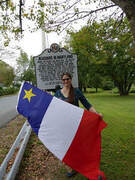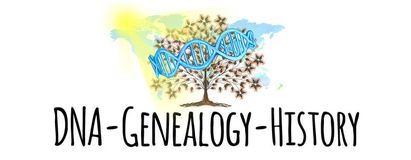|
On the 24th of September, 2017, I was honored to deliver a presentation about genetic genealogy to the Washington, D.C. Society of Mayflower Descendants. Normally I am engaged with audiences who share my interest in descendants of Acadians, as this is the ancestry I have traced, primarily, through DNA testing. In this case, the Governor of the Society, Glennon Harrison, reached out to me to present to his group, as he was interested in my research of Acadian ancestries using traditional genealogy research, history, and DNA tests and believed it would be fascinating to have a speaker who could speak knowledgeably about using DNA results as a major part of genealogical analysis. Glennon also mentioned that the society had started a Mayflower DNA project and was beginning to use DNA test results as part of the membership qualification process (the Mayflower society has particularly stringent rules for genealogical line verification). His invitation offered a perfect opportunity to present all the ways that Y chromosome DNA, mitochondrial DNA (mtDNA), and autosomal DNA (including the X chromosome) could be used to help with genealogies -- referencing about 10 years of case studies!
During every presentation I've delivered, I've always made special connections with my audiences and although I do not have records of my own family's Mayflower ancestry at this time, I was happy to meet the members and share insights -- and reunite, unexpectedly, with one of my favorite former clients from my professional consulting life at the Department of Energy who showed up with his wife (who was also a member), who decided to attend the presentation when he saw my name, and the topic of genetic genealogy, on the program. I also connected with another member who who came up to me following the presentation and asked me, "Was I Asselia Lichliter's granddaughter?" (how long had it been since I had heard that question?). Asselia Lichliter was a matrilinial descendant of Anne Marie (?) Amerindian / First Nations / Metis / Mi'kmaq / Metis / Metisse of Port Royal Acadia b. ca 1625 - 1631-- as was her daughter, Nancy (my late mother) and as am I! My grandmother, Asselia S. Lichliter, was an editor on Capitol Hill during her career there, and in her "second life" (we don't retire in our family -- we take on "second lives"), an avid genealogist who combined history and genealogy in the same way that I now combine history, genealogy and DNA to research, document and publish family histories. My middle name, "Asselia," mentioned in reference to my grandmother Asselia's extensive research of her Beville lineage in the United States, England and France, was the tip-off and the Mayflower society member recalled my grandmother right away and remarked that she had known my late grandmother when she was an active member of the National Genealogical Society (based in Arlington, Virginia). Click here to read a bulletin that includes an article, "Thank you, Asselia Lichliter," about my grandmother and her work as a long-time volunteer and benefactor of the NGS. Anne Marie's DNA is instrumental in reuniting her descendants throughout the US and Canada -- and now her DNA is also reconnecting me, although indirectly, with former clients and people who knew my grandmother (also Anne Marie's direct descendant). We are all related!
Greg Wood, Marty Guidry and Marie Rundquist were the keynote speakers and presenters during the historical journey of the Acadian experience in Maryland that took place between the morning of Wednesday, September 13th through the afternoon of Friday September 15th. The tour group, comprised of Acadian descendants from Canada, largely Nova Scotia, New Brunswick, and Quebec, visited Acadian diaspora sites in Baltimore, the White Marsh Ruins, Snow Hill, Furnacetown, Princess Anne, Oxford and Annapolis during the carefully planned three-day sojourn into some of Maryland's most historic locations. We are Acadians in Maryland!
"Ave Maris Stella," the National Anthem of the Acadian people, is sung in front of the "Acadians in Maryland" sign at the Manokin River Park in Princess Anne, Maryland to honor Acadian ancestors who lived in the area after being deported there, by the British, in November of 1755.
 Photo Courtesy Edward Nowicki Photo Courtesy Edward Nowicki
Marie Rundquist, author, holds the Acadian flag while standing in front of the "Acadians in Maryland" sign in Princess Anne, Maryland. Marie is the descendant of Acadians Genevieve Hebert and Michel David dit St. Michel who were deported from Grand-Pré to Maryland in 1755. Genevieve Hebert was the great granddaughter of Anne Marie (?), an Amerindian woman (said to be Mi'kmaq or possibly Métis) out of Port Royal, Nova Scotia who married two French settlers in Acadia, first, the unknown Pinet, and then second, Rene Rimbault, in the mid-17th century.
For more information about the history of Acadian exiles in Maryland, visit http://acadianswerehere.org. For information about the tour group, and when the next tour will be scheduled, visit Les Voyages DiasporAcadie ! and email [email protected]
The following slide shows, videos and shares offer a personal insight into the events and meetings that took place throughout all the days of celebration and learning that comprised the Grand-Pré 2017 Celebration of Peace and Reconciliation:
During this first-ever, four-day reunion of the Acadian and Mi'kmaq people, held at the Grand-Pré World UNESCO site in Nova Scotia, festival participants had an opportunity to take part in an historic renewal of friendship, exchanging of gifts, song, dance, and culture among Mi'kmaq and Acadian peoples, and the acknowledgement of a 400 year-old shared history, tradition and legacy in Nova Scotia. The historical timeline of Nova Scotia, and specifically, "Acadia," reflects two cataclysms: first, the coming together of two distinct peoples from two separate continents, Europe and North America, that occurred in the early 1600s, when Europeans (largely from France) first settled lands held by the Mi'kmaq and intermarriage took place, and second, the involuntary expulsion of the Acadian peoples out of Nova Scotia in 1755 who then carried Native and European blood lines borne of these first historic unions to their new homes and settlements. Now, in 2017, we may add to this same timeline a third milestone: the Celebration of Peace and Reconciliation that took place at Grand Pré.
|
Archives
May 2025
Categories
All
|
DNA-Genealogy-History.com Site Index:
Copyright 2025 Marie Rundquist., DNA Genealogy History, LLC
DNA Genealogy History, LLC is a registered S Corporation with the State of Virginia and the Federal Government since 2017, is a retailer and distributor of books and digital publications, and is certified, authorized and empowered to collect Sales and Use Tax for the Commonwealth of Virginia.
E-Mail Your Comments to [email protected]
This website is not intended for users located within the European Economic Area.
DNA Genealogy History, LLC is a registered S Corporation with the State of Virginia and the Federal Government since 2017, is a retailer and distributor of books and digital publications, and is certified, authorized and empowered to collect Sales and Use Tax for the Commonwealth of Virginia.
E-Mail Your Comments to [email protected]
This website is not intended for users located within the European Economic Area.


 RSS Feed
RSS Feed
